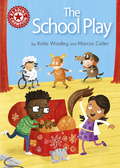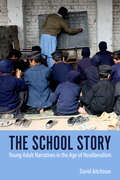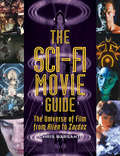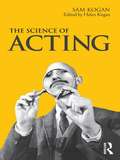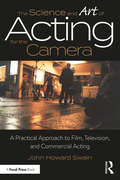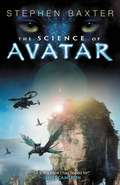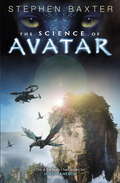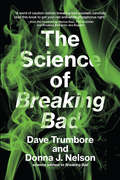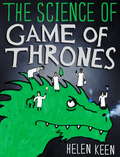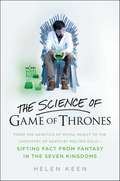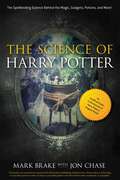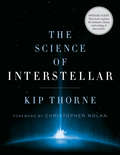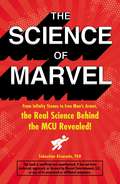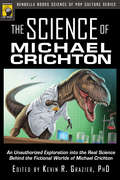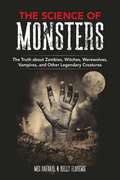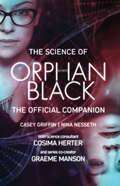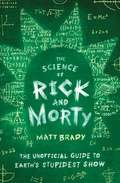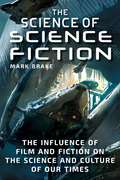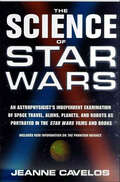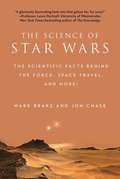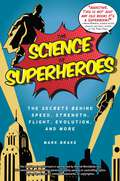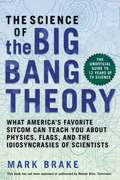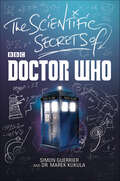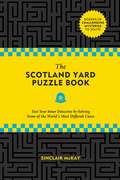- Table View
- List View
The School Play: Independent Reading Red 2 (Reading Champion #367)
by Katie WoolleyLil and Tim are having trouble choosing an outfit for the school play ... what will they be?Reading Champion offers independent reading books for children to practise and reinforce their developing reading skills.Fantastic, original stories are accompanied by engaging artwork and a reading activity. Each book has been carefully graded so that it can be matched to a child's reading ability, encouraging reading for pleasure. Perfect for the 4-5 year old beginner reader or those reading book band red.
The School Story: Young Adult Narratives in the Age of Neoliberalism (Children's Literature Association Series)
by David AitchisonThe School Story: Young Adult Narratives in the Age of Neoliberalism examines the work of contemporary writers, filmmakers, and critics who, reflecting on the realm of school experience, help to shape dominant ideas of school. The creations discussed are mostly stories for children and young adults. David Aitchison looks at serious novels for teens including Laurie Halse Anderson’s Speak and Faiza Guène’s Kiffe Kiffe Tomorrow, the light-hearted, middle-grade fiction of Andrew Clements and Tommy Greenwald, and Malala Yousafzai’s autobiography for young readers, I Am Malala. He also responds to stories that take young people as their primary subjects in such novels as Sapphire’s Push and films including Battle Royale and Cooties. Though ranging widely in their accounts of young life, such stories betray a mounting sense of crisis in education around the world, especially in terms of equity (the extent to which students from diverse backgrounds have fair chances of receiving quality education) and empowerment (the extent to which diverse students are encouraged to gain strength, confidence, and selfhood as learners). Drawing particular attention to the influence of neoliberal initiatives on school experience, this book considers what it means when learning and success are measured more and more by entrepreneurship, competitive individualism, and marketplace gains. Attentive to the ways in which power structures, institutional routines, school spaces, and social relations operate in the contemporary school story, The School Story offers provocative insights into a genre that speaks profoundly to the increasingly precarious position of education in the twenty-first century.
The Sci-Fi Movie Guide
by Chris BarsantiOnce upon a time, science fiction was only in the future. It was the stuff of drive-ins and cheap double-bills. Then, with the ever-increasing rush of new, society-altering technologies, science fiction pushed its way to the present, and it busted out of the genre ghetto of science fiction and barged its way into the mainstream. What used to be mere fantasy (trips to the moon? Wristwatch radios? Supercomputers capable of learning?) are now everyday reality.Whether nostalgic for the future or fast-forwarding to the present, The Sci-Fi Movie Guide: The Universe of Film from Alien to Zardoz covers the broad and widening range of science-fiction movies. From the trashy to the epic, from the classics to today's blockbusters, this cinefile's guidebook reviews nearly 1,000 of the biggest, baddest, and brightest from every age and genre of cinematic and TV science fiction. You'll find more than just Star Wars, Star Trek, and Transformers, with reviews on many overlooked and under-appreciated gems and genres, such as Monsters! Pacific Rim, Godzilla, The Thing, Creature from the Black Lagoon Superheroes: Thor, Iron Man, X-Men, The Amazing Spider-man, Superman Avant-garde masterpieces: Solaris, 2001, Brazil and much more!!
The Science Of Acting
by Sam KoganWhat is good acting? How does one create believable characters? How can an actor understand a character if they do not understand themselves? In The Science of Acting, Sam Kogan uses his theories on the relationship between neuroscience, psychology and acting to answer these questions. Practical exercises provide a step-by-step guide to developing an actor's ability, culminating in Ten Steps to Creating a Character. He presents the reader with a groundbreaking understanding of the subconscious and how it can be applied to their acting. The author’s highly original perspective on Stanislavski's teaching gives readers a unique insight into their character’s minds. Sam Kogan studied at the Moscow Institute of Theatre Arts (now the Russian Academy of Theatre Arts) under the tutelage of Professor Maria Knebel. He established The Science of Acting, a complete stand-alone technique. Helen Kogan is the chair and former principal of The Academy of Science of Acting and Directing, has helped to shape her father's words and work for the publication of this book.
The Science and Art of Acting for the Camera: A Practical Approach to Film, Television, and Commercial Acting
by John Howard SwainThe Science and Art of Acting for the Camera provides a precise yet practical approach to help unlock the mysteries of acting for film and television. Written by veteran actor, producer, and director John Howard Swain, the book offers a clear-cut, no-nonsense technique that equips aspiring or working actors with the necessary skills to succeed on camera. The technique teaches you how to build multi-dimensional characters; construct truthful and exciting relationships; ignite stimulating emotions; craft a series of discoveries guaranteed to energize your work; and much, much more. The book also provides instruction for actors working in commercials—from slating, to the dreaded "tell us about yourself" interview, to nailing "the tag" and embracing the cliché—and supplies sample commercial copy for students to practice.
The Science of Avatar
by Stephen BaxterAudiences around the world have been enchanted by James Cameron's visionary Avatar, with its glimpse of the Na'vi on the marvelous world of Pandora. But the movie is not entirely a fantasy; there is a scientific rationale for much of what we saw on the screen, from the possibility of travel to other worlds, to the life forms seen on screen and the ecological and cybernetic concepts that underpin the 'neural networks' in which the Na'vi and their sacred trees are joined, as well as to the mind-linking to the avatars themselves.From popular science journalist and acclaimed science fiction author Stephen Baxter, THE SCIENCE OF AVATAR is a guide to the rigorous fact behind the fiction. It will enhance the readers' enjoyment of the movie experience by drawing them further into its imagined world.
The Science of Avatar
by Stephen BaxterJames Cameron's Avatar is the biggest movie of all time. Now the movie's legendary director has leant his support to an exploration of the world of Pandora with bestselling science-fiction author Stephen Baxter. From journeys into deep space to anti-gravity unobtanium, from Pandora's extraordinary flora and fauna to transferring consciousness, Baxter and Cameron reveal that we are often closer to world of Avatar than we might imagine.Stephen Baxter is the master of `what-if?' science fiction. In THE SCIENCE OF AVATAR he's written a book that will appeal to fans of both science-fiction and popular science. THE SCIENCE OF AVATAR will offer fans the unique opportunity to explore the spectacular world of Pandora, from the creator himself.
The Science of Breaking Bad (The\mit Press Ser.)
by Dave Trumbore Donna J. NelsonAll the science in Breaking Bad—from explosive experiments to acid-based evidence destruction—explained and analyzed for authenticity.Breaking Bad's (anti)hero Walter White (played by Emmy-winner Bryan Cranston) is a scientist, a high school chemistry teacher who displays a plaque that recognizes his “contributions to research awarded the Nobel Prize.” During the course of five seasons, Walt practices a lot of ad hoc chemistry—from experiments that explode to acid-based evidence destruction to an amazing repertoire of methodologies for illicit meth making. But how much of Walt's science is actually scientific? In The Science of “Breaking Bad,” Dave Trumbore and Donna Nelson explain, analyze, and evaluate the show's portrayal of science, from the pilot's opening credits to the final moments of the series finale. The intent is not, of course, to provide a how-to manual for wannabe meth moguls but to decode the show's most head-turning, jaw-dropping moments. Trumbore, a science and entertainment writer, and Nelson, a professor of chemistry and Breaking Bad's science advisor, are the perfect scientific tour guides.Trumbore and Nelson cover the show's portrayal of chemistry, biology, physics, and subdivisions of each area including toxicology and electromagnetism. They explain, among other things, Walt's DIY battery making; the dangers of Mylar balloons; the feasibility of using hydrofluoric acid to dissolve bodies; and the chemistry of methamphetamine itself. Nelson adds interesting behind-the-scenes anecdotes and describes her work with the show's creator and writers. Marius Stan, who played Bogdan on the show (and who is a PhD scientist himself) contributes a foreword. This is a book for every science buff who appreciated the show's scientific moments and every diehard Breaking Bad fan who wondered just how smart Walt really was.
The Science of Game of Thrones: A myth-busting, mind-blowing, jaw-dropping and fun-filled expedition through the world of Game of Thrones
by Helen KeenA myth-busting, mind-blowing, jaw-dropping and fun-filled expedition through the world of Game of Thrones.Do dragons actually exist? Is it possible to crush a person's head with your bare hands?What really happened when royal families interbreed? How does wildfire win wars? Can you really kill someone with molten gold?Award-winning comedian and popular-science writer Helen Keen uncovers the astounding science behind the world's most popular television show. Join Helen as she sifts the fact from fantasy, discovers the truth beneath the togas, and reveals a world more fantastical than Daenerys Targaryen's wildest dreams. So pour yourself a bowl of brown, climb on your beast of burden, and prepare yourself for an amazing adventure. It's time to see the Seven Kingdoms as you have never seen them before.
The Science of Game of Thrones: From the genetics of royal incest to the chemistry of death by molten gold - sifting fact from fantasy in the Seven Kingdoms
by Helen KeenA myth-busting, jaw-dropping, fun-filled tour through the science of your favorite fantastical world. Award-winning comedian and popular-science writer Helen Keen uncovers the astounding science behind the mystical, blood-soaked world of Game of Thrones, answering questions like: Is it possible to crush a person's head with your bare hands? What really happens when royal families interbreed? Does Cersei have Borderline Personality Disorder? What curious medical disorder does Hodor suffer from? And more. Join Keen as she investigates wildfire, ice walls, face transplants, and every wild feature of Westeros and beyond, revealing a magical world that may be closer to our own than we think. The Science of Game of Thrones is the ultimate guide to the epic series as well as the perfect gift for science-lovers and fans. So pour yourself a bowl of brown, climb on your beast of burden, and prepare yourself to see the Seven Kingdoms as you have never seen them before.
The Science of Harry Potter: The Spellbinding Science Behind the Magic, Gadgets, Potions, and More! (The Science of Series)
by Mark Brake Jon ChaseHow does magic in J. K. Rowling’s universe work? Finally, the scientific secrets are revealed!The story of the boy who lived has brought the idea of magic and sorcery into mainstream fruition more than any other book series in history. Modern muggle scientists have uncovered explanations to the seemingly impossible, including answers to such questions as: Will we ever see an invisibility cloak? How hazardous is a flying broomstick like the Nimbus 2000? How has medicine made powerful potions from peculiar plants? (Felix Felicis, anyone?) Can scientists ever demonstrate Wingardium Leviosa, or the flying power of a Golden Snitch? Is it possible to stupefy someone? And many more!Often perceived as a supernatural force, magic captivates and delights its audience because of its seeming ability to defy physics and logic. But did you ever wonder if science has any explanation for these fantastic feats? The Science of Harry Potter examines the scientific principles—behind some of your favorite characters, spells, items, scenes, and even games like Quidditch and Wizard’s Chess—from boy wizard Harry Potter’s world, providing in-depth analysis and scientific facts to support its theories. Author Mark Brake, whose The Science of Star Wars was a knockout success, has found the answers to satisfy the curious spirits of muggles everywhere…A perfect Harry Potter gift for anyone obsessed enough to stand in line to be the first to see Harry Potter and the Cursed Child or Fantastic Beasts and Where to Find Them, witches and wizards alike will be fascinated by the merging of this improbable realm and real science!
The Science of Interstellar
by Kip ThorneA journey through the otherworldly science behind Christopher Nolan's highly anticipated film, Interstellar, from executive producer and theoretical physicist Kip Thorne.
The Science of Marvel: From Infinity Stones to Iron Man's Armor, the Real Science Behind the MCU Revealed!
by Sebastian AlvaradoScience meets fantasy in this behind-the-scenes look at the Marvel Cinematic Universe—now you can experience the magic of the movies, and learn how to replicate it in real-life. The Marvel Cinematic Universe is filled with extraordinary humans and abilities. There are teenaged geniuses swinging through the streets of New York, billionaires creating impenetrable armor in hidden caves, and aliens flying through wormholes to Earth. All of these characters seem to lie firmly in the realm of fantasy—but the technology behind them might not be as farfetched as you think… The Science of Marvel pulls back the curtain and reveals the secrets behind Marvel movie magic, and shows us how to recreate these comic book wonders in our everyday life. Using quantum physics, a little bit of mechanical engineering, and some out-of-the-box thinking, you’ll be amazed to discover that it’s possible to create a real-life Captain America, Incredible Hulk, or Black Panther. The perfect gift or collectible for Marvel fans everywhere, The Science of Marvel brings beloved movies and characters to life like never before.
The Science of Michael Crichton: An Unauthorized Exploration into the Real Science Behind the Fictional Worlds of Michael Crichton
by Michael CrichtonMichael Crichton’s thrillers traverse the cutting edge of science and then push the envelope. How realistic are his takes on subjects ranging from dinosaur cloning to global warming, nanotechnology to time travel, animal behavior to human genetics? The Science of Michael Crichton gathers essays from prominent experts that examine the amazing inventions of Crichton’s books and lift up the hood, revealing the science underneath—exploring which Crichton imaginings are feasible and which are just plain impossible. Computer science innovator Ray Kurzweil looks at how virtual reality is portrayed in The Terminal Man; anthropologist Ian Tattersall takes on Crichton’s depiction of Neanderthals in Eaters of the Dead; meteorologist David Lawrence discusses global warming in State of Fear—and much more, in a fascinating volume that separates the science from the fiction.
The Science of Monsters: The Truth about Zombies, Witches, Werewolves, Vampires, and Other Legendary Creatures
by Meg Hafdahl Kelly FlorenceA must-have for any fan of horror and fantasy movies—Night of the Living Dead, A Nightmare on Elm Street, The Shining (Stephen King), and so many more! If you love film that scares, and want to believe that zombies, vampires, and other deadly and terrifying creatures could be real, let Meg Hafdahl and Kelly Florence, the women behind the Horror Rewind podcast called “the best horror film podcast out there” by Film Daddy, take you to the world where horror and science meet. How would a zombie really decompose in Night of the Living Dead?Are there instances of shape shifting in nature like in The Wolf Man?What is the science behind the night terrors that inspired the creation of Freddy Krueger?Is there scientific data supporting ghost detection like the tools used in Poltergeist?What is the psychological drive that compels cannibals like Hannibal Lecter?How does modern medicine and therapy differ from what would have been offered to Norman Bates in 1960?How are subliminal messages related to propaganda or brainwashing like in The Ring?What would the scientific explanation be for witches possessing people like in Carrie?Was The Blair Witch Project based on any real or imagined creature that came before?”And so much more! Gothic media moguls Meg Hafdahl and Kelly Florence revisit the films from their childhood to discover the science behind the fear. Join Kelly and Meg as they unravel the medical mysteries and scientific marvels that inspired the creation of famous monsters like Nosferatu, Norman Bates, Dracula, Frankenstein, and many more. An approachable and frightfully fun examination of what goes bump in the night, The Science of Monsters will thrill every horror fan.
The Science of Orphan Black: The Official Companion
by Casey Griffin Nina Nesseth Cosima Herter Graeme MansonAn official guide to the crazy science of Orphan Black—from cloning to chimerism and much more. Delve deeper into the scientific terms and theories at the core of the Peabody-winning cult-favorite show. With exclusive insights from the show&’s co-creator Graeme Manson and science consultant Cosima Herter, The Science of Orphan Blacktakes you behind the closed doors of the Dyad Institute and inside Neolution, with color photos included. Authors Casey Griffin and Nina Nesseth decode the mysteries of Orphan Black—from the history of cloning, epigenetics, synthetic biology, chimerism, the real diseases on which the clone disease is based, and the transhumanist philosophies of Neolution, to what exactly happens when a projectile pencil is shot through a person&’s eye and into their brain.
The Science of Rick and Morty: The Unofficial Guide to Earth's Stupidest Show
by Matt BradyExplore the real science behind the Cartoon Network phenomenon Rick and Morty—one of television’s most irreverent, whip-smart, and darkly hilarious shows—and discover how close we are to Rick’s many experiments becoming a reality. Adult Swim’s Rick and Morty is one of the smartest (and most insane) shows on television. Genius alcoholic Rick Sanchez and his hapless grandson Morty have explored everything from particle physics to human augmentation and much more in their intergalactic adventures through the multiverse. With biting humor and plenty of nihilism, Rick and Morty employs cutting-edge scientific theories in every episode. But, outside of Rick’s garage laboratory, what are these theories truly about and what can they teach us about ourselves? Blending biology, chemistry, and physics basics with accessible—and witty—prose, The Science of Rick and Morty equips you with the scientific foundation to thoroughly understand Rick’s experiments from the show, such as how we can use dark matter and energy, just what is intelligence hacking, and whether or not you can really control a cockroach’s nervous system with your tongue. Perfect for longtime and new fans of the show, this is the ultimate segue into discovering more about our complicated and fascinating universe.
The Science of Science Fiction: The Influence of Film and Fiction on the Science and Culture of Our Times
by Mark BrakeWe are the first generation to live in a science fiction world.Media headlines declare this the age of automation. The TV talks about the coming revolution of the robot, tweets tell tales of jets that will ferry travelers to the edge of space, and social media reports that the first human to live for a thousand years has already been born. The science we do, the movies we watch, and the culture we consume is the stuff of fiction that became fact, the future imagined in our past—the future we now inhabit.The Science of Science Fiction is the story of how science fiction shaped our world. No longer a subculture, science fiction has moved into the mainstream with the advent of the information age it helped realize. Explore how science fiction has driven science, with topics that include:Guardians of the Galaxy: Is Space Full of Extraterrestrials?Jacking In: Will the Future Be Like Ready Player One?Mad Max: Is Society Running down into Chaos?The Internet: Will Humans Tire of Mere Reality?Blade Runner 2049: When Will We Engineer Human Lookalikes?And many more! This book will open your eyes to the way science fiction helped us dream of things to come, forced us to explore the nature and limits of our own reality, and aided us in building the future we now inhabit.
The Science of Star Wars: An Astrophysicist's Independent Examination of Space Travel, Aliens, Planets, and Robots as Portrayed in the Star Wars Films and Books
by Jeanne CavelosCould the science fiction of Star Wars be the actual science of tomorrow?-How close are we to creating robots that look and act like R2-D2 and C-3PO?-Can we access a "force" with our minds to move objects and communicate telepathically with each other?-How might spaceships like the Millennium Falcon make the exhilarating jump into hyperspace?-What kind of environment could spawn a Wookiee?-Could a single blast from the Death Star destroy an entire planet?-Could light sabers possibly be built, and if so, how would they work?-Do Star Wars aliens look like "real" aliens might?-What would living on a desert planet like Tatooine be like?-Why does Darth Vader require an artificial respirator?Discover the answers to these and many other fascinating questions of physics, astronomy, biology and more, as a noted scientist and Star Wars enthusiast explores The Science of Star Wars.
The Science of Star Wars: The Scientific Facts Behind the Force, Space Travel, and More!
by Mark Brake Jon ChaseDiscover the science behind the most popular sci-fi franchise of all time.Capturing the imagination and hearts of crowds worldwide, Star Wars is a fantastic feat of science fiction and fantasy. <P><P>We marvel at the variety of creatures and technology and the mystery behind the force. But how much of the Star Wars world is rooted in reality? Could we see some of the extraordinary inventions materialize in our world? <P><P>The Science of Star Wars addresses fifty topics that span the movies' universe such as battle technology, alien life, space travel, etc. You'll find fascinating explorations of physics, plausibility, and more. The book addresses many unanswered, burning questions including: <P><P>How long before we get a Star Wars speeder off the ground? <P><P>What exactly is the Force? <P><P>How could Kylo Ren stop a blaster shot in mid-air?How could we live on a gas giant like Bespin?Nature versus nurture: How does it play out in the making of Jedi? <P><P>How much would it cost to build the Death Star? <P><P>And much more!Written for every fan of the films, you don't need to be a Jedi or a scientist to appreciate all of Mark Brake and Jon Chase's fun and informative analysis of this classic series. Prepare your mind to make the jump to light speed and find out about the facts behind one of our favorite modern epics.
The Science of Superheroes: The Secrets Behind Speed, Strength, Flight, Evolution, and More (The\science Of Ser.)
by Mark BrakeDiscover the science behind the abilities of your favorite superheroes! The concept of the superhero has permeated our culture. They fascinate their fans with their incredible superhuman abilities and impressive technology. But do you ever wonder if any of it is plausible or rooted in fact? Enter The Science of Superheroes, which address more than fifty topics that span the worlds of your favorite superheroes and villains. Explore and examine their amazing abilities and fantastic gadgets with a detailed scientific lens. The scientific questions examined within this book include: Can an Iron Man suit be made? How does Thor's hammer work? Could any known forms of radiation cause superpowers? How many calories does Superman need each day? Could you cross a Lamborghini and a hummer to make the Batmobile Tumbler? And many more! Whether you're a movie or comic buff, this book is certain to entertain and open your eyes to the truth behind these amazing characters.
The Science of The Big Bang Theory: What America's Favorite Sitcom Can Teach You about Physics, Flags, and the Idiosyncrasies of Scientists (The Science of Series)
by Mark BrakeThe geeks will inherit the earth.With well over two hundred episodes and a dozen seasons, The Big Bang Theory is one of America’s favorite television series, bringing a new class of character to mainstream television: the science nerd.In spite of its evident popularity and influence in shaping public attitudes to science and scientists, there are relatively few books that explore the show’s culture and social dimension. The Science of The Big Bang Theory looks behind the comedy scenes and scripts of this long-running and successful TV show to explore topics such as:The Bachelor Party Corrosion and ArchimedesThe Valentino Submergence: Fun with FlagsThe Dumpling Decoupling: Sheldon and Doctor WhoThe Mystery Date Observation: The Unlikely Dating Habits of EggheadsAnd More!This book is a light-hearted science companion to TV's The Big Bang Theory, providing you with just the kind of dissection of the science and culture you’d need to understand “math, science, history, unraveling the mysteries, that all started with the big bang! Hey!”
The Scientific Secrets of Doctor Who
by Simon Guerrier Marek KukulaThe Scientific Secrets of Doctor Who is a mind-bending blend of story and science that will help you see Doctor Who in a whole new light, weaving together a series of all-new adventures, featuring every incarnation of the Doctor.With commentary that explores the possibilities of time travel, life on other planets, artificial intelligence, parallel universes and more, Simon Guerrier and Dr. Marek Kukula show how Doctor Who uses science to inform its unique style of storytelling—and just how close it has often come to predicting future scientific discoveries.This book is your chance to be the Doctor's companion and explore what's out there. It will make you laugh, and think, and see the world around you differently.
The Scooby-Doo! Cookbook: Kid-Friendly Recipes for the Whole Gang (Scooby-Doo!)
by Katrina JorgensenGuaranteed to solve any case of hunger! This official Scooby-Doo! cookbook features—Zoinks!—more than 25 kid-friendly recipes from the Mystery Inc. gang, including Scooby’s favorite treats, Shaggy’s must-have cheese-and-pickles pizza, jaw-stretcher sandwiches, and other easy recipes. Jam-packed with bright photos, cooking basics, and fun facts from the ever-popular show, the SCOOBY-DOO! COOKBOOK is sure to please fans of all ages, from meddling kids to adults. Rummy
The Scotland Yard Puzzle Book: Test Your Inner Detective by Solving Some of the World's Most Difficult Cases
by Sinclair McKayPit your wits against the brilliant minds of Scotland Yard and see if you have what it takes to solve dozens of the world's toughest crimes."Scotland Yard" conjures up so much more than just London's Metropolitan Police. Since it opened its doors in 1829, Scotland Yard has been synonymous the world over with the highest level of detective work and famous for its ability to solve the most macabre of murders and catch the most audacious of thieves.The Scotland Yard Puzzle Book mines the history of this famous institution to recreate some of the most complex conundrums its detectives have ever faced. Armchair detectives can now try their hand and keen powers of observation and deduction to solve for themselves dozens of the most difficult and challenging cases.Activities include:Anagrams and cryptogramsLogic, linguistic, and mathematical puzzlesMap puzzlesCoded and visual puzzlesBrainteasersHidden messagesAnd more (answers are provided in the back of the book)!
